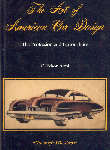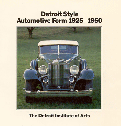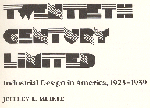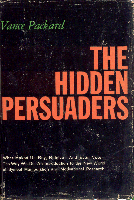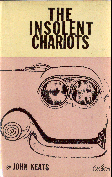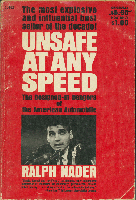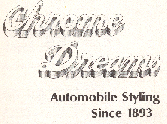
A History of Scholarship on American Automobile Design
Annotated Bibliography
Armi, Edson. The Art of American Automobile Design. University Park: Pennsylvania State University Press, 1988. A detailed and thorough analysis of the development of the profession of automobile design, its organization and practices, that treats design as a high art. The extensive excerpts from the author’s interviews with designers are a fascinating window on the profession and its personalities.
Automobile and Culture. New York: Harry Abrams, 1984. A beautiful, lavishly illustrated and well-produced volume accompanying the exhibit by the Museum of Contemporary Art in Los Angeles. Most of the volume is taken up with an essay on the image of the automobile in high art, but there are also good essays on hot rods, American design, and European design.
Reyner Banham. Design By Choice. New York: Rizzoli, 1981. A good collection of this British design critic’s most important essays, including those defending and praising American automobile design. Banham’s arguments are not always convincing, but they are always entertaining. His dedication to a democratic and popular culture is refreshing.
Stephen Bayley. Harley Earl and the Dream Machine. New York: Knopf, 1983. An interesting and light introduction to the career and cars of the most influential auto designer of all times. The book is flawed, however, by a psychological-reductionist interpretation of design.
Stephen Bayley. Sex, Drink and Fast Cars. New York: Pantheon, 1986. More ride-ranging than Bayley’s Harley Earl, covering the meanings of cars in high and low culture. The psychologism is a bit more complex here, but narrow nonetheless.
“The Body Beautiful.” Industrial Design, June, 1950, pp. 112-19. An account of the symposium on automobile design held at the Museum of Modern Art in April, 1950, which formed the basis of the museum’s “Eight Automobiles” exhibit. This a wonderful example of the snobby criticism of automobiles by those infected with European theory.
Pierre Bourdieu. The Field of Cultural Production: Essays on Art and Literature. New York: Columbia University Press, 1993. The collected essays by this French sociologist provide the conceptual basis for my sociological insights on the cultural tastes of classes and the differences between high art and popular culture.
Detroit Style: Automotive Form, 1925-1950. Detroit: Detroit Institute of Arts, 1985. A well-illustrated catalog accompanying the exhibit at the Detroit Institute of Arts. Taragin’s essay tries to force auto design into the high-art perspective. But the essay by Strother MacMinn and Michael Lamm is more informative and down-to-earth.
Eight Automobiles. New York: Museum of Modern Art, 1951. The first attempt to treat autos as an art form. The selections and analysis in this thin catalog are rather elitist, but interesting nonetheless.
David Gartman. Auto Opium: A Social History of American Automobile Design. London: Routledge. A sociologically oriented history of auto design that adopts a critical perspective on the industry. The historical narrative shows design influenced by the business, professional, and social struggles of American society.
Nick Georgano. Art of the American Automobile: The Greatest Stylists and Their Work. New York: Smithmark, 1995. A popular account focused on individual designers and their cars. This focus leads to a confusing organization and a lack of chronological sense. Leans heavily on secondary sources.
Thomas Hine. Populuxe. New York: Knopf, 1996. A highly enjoyable but sophisticated social analysis of the design of mass-produced consumer goods in America between 1954 and 1964. Well-illustrated and a fun read. The chapter on auto design is a gem.
John Keats. The Insolent Chariots. Philadelphia: J.B. Lippincott, 1958. A lively, popular bashing of the American cars of the 1950s. It is simplistic, but still of value, if only as a reflection of the consumer psyche of the period.
Michael Lamm and David Holls. A Century of Automotive Style: 100 Years of American Car Design. Stockton, CA.: Lamm-Morada Publishing, 1996. The most thorough and detailed account of American auto design available, by two industry insiders. Almost encyclopedic in scope, the book contains numerous sidebars explaining each step of the design process. But the details get in the way of the big picture, and the account is totally devoid of a critical perspective.
Jeffrey Meikle. Twentieth Century Limited: Industrial Design in America, 1925-1939. Philadelphia: Temple University Press, 1979. A sophisticated social analysis of the rise of the profession and practice of industrial design in this period. The book places the aesthetics of consumer goods in the context of the tumultuous social changes undergone by America during this crucial period. Meikle’s analysis of the streamlined cars of the 1930s is unmatched.
Ralph Nader. Unsafe at Any Speed: The Designed-In Dangers of the American Automobile, updated edition. New York: Grossman, 1972. This classic of muckraking automotive journalism is still a shocking and relevant book. The chapter on the stylists is delightfully merciless.
Vance Packard. The Hidden Persuaders, revised edition. New York: Pocket Books, 1980. An updated version of the 1957 classic work on consumer manipulation, including a new introduction and epilogue. Packard’s arguments now seem simplistic and paranoid, but it is a good reflection of the consumer fears of the period.
Penny Sparke. A Century of Car Design. Hauppage, NY: Barron’s Educational Series, 2002. A popularly oriented but well-informed and -researched history of both American and European auto design. The book gives an enlightening account of the recent trend toward “lifestyle cars” and the “branding” of autos.
Paul C. Wilson. Chrome Dreams: Automobile Styling Since 1893. Radnor, PA: Chilton Books, 1976. A useful, measured analysis of automobile design that treats it as a popular art tied to the changing aspirations and needs of the American public. The book focuses on the cars themselves, rather than the profession and personalities of design.
<<Previous Section - Next Section>>
Introduction
Harley Earl and the Dream Machine
Detroit Style: Automotive Form, 1925-1950
©2004 Automobile in American Life and Society
